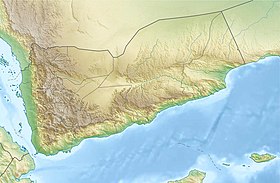Tawila cisterns
The Tawila cisterns in what is now Yemen |

The cisterns of Tawila (also tanks of Aden , Arabic صهاريج عدن, DMG Ṣahārīǧ ʿAdan orصهاريج الطويلة / Ṣahārīǧ aṭ-Ṭawīla ) are a water collection system on the outskirts of the Crater district of Aden in southern Yemen , which was probably established in ancient times and has been expanded to the present day . The system served to supply the urban population with drinking water. With the cisterns the cardinal problem of the region was countered, that is the extremely irregular rainfall. Heavy rains can occur, but over the year only 50 mm come together, and the water from the Jebel Shamsan flowed unused into the sea . The complex is named after the Wadi at-Tawila , which thanks to its deep valley incision collected most of the water on the east side of the massif. Today, Aden is no longer supplied via the system, but receives its drinking water via a pipeline from wells in the area.
history
The Tawila cisterns are considered to be one of the outstanding historical engineering achievements in the South Arabian world. Its construction is presumed to have started during the rule of the Himyars , but without a date during their long period of power from the 1st century BC. BC to 570 AD, or even to be able to provide evidence of it. However, this hypothesis is supported by the fact that the Himyars were generally good at water management and that Aden, despite the Himyarite power center in Zafar , belonged to the narrow sphere of influence. A puzzling open space in front of one of the large tanks, the Coghlan tank , could have been significant as an animal sacrifice site. As the last pre-Islamic dynasty, the Himyars gave preference to animal sacrifices in times of drought in order to ask for economic blessings. The visitor to the cisterns consequently comes across the note: "Regarding the original construction of which nothing is accurately known ..." - translated roughly: "With regard to the original architecture, nothing is known exactly ..."
Since the beginning of the Islamic calendar in the 7th century, records have been made about the Tawila cisterns. The Yemeni scholar Abu Muhammad al-Hasan al-Hamdani noted in his notes in the 10th century: “Aden has tanks that store water when the rain falls,” - translated as: “Aden has tanks that store water when the Rain falls ” . Three centuries later, Al-Makdsi followed up with this statement. Under the Rasulids , who were known for flourishing world trade, the now almost dilapidated cisterns were restored and structurally expanded. After the Rasulid era, which lasted from 1228 to 1454, the tanks fell back into neglect and fell into disrepair again, with vast amounts of rubble building up. The Tahirids and Ottomans were later associated with the cisterns.
On January 16, 1839, Great Britain conquered the city on a peninsula , which at the time was still insignificant. The cisterns were almost completely washed up by rubble from the mountains due to successive floods. In 1854 the cisterns were uncovered by the British and from 1857 they were extensively restored. Since then, construction and arrangement have deviated considerably from the original state. Presumably important traces of the original condition of the cisterns were also erased.
Today the cisterns are primarily a public park and a tourist attraction.
Capacities and type
The system consists of a number of containers of different shapes and capacities. They are networked with each other. Originally there were 53 individual tanks, but only 13 of them remained after the renovations of the facility in the 19th century by the British colonial powers. The cisterns in existence today have a total capacity of more than 19,000,000 gallons .
The cisterns were built from hewn volcanic rock from Wadi at-Tawila , which could be processed into cement using a stucco enriched with volcanic ash , which made the tank walls impermeable so that the water could be kept and metered over a longer period of time.
literature
- Horst Kopp (Editor): Regional Geography Yemen , Dr. Ludwig Reichert Verlag Wiesbaden, 2005, ISBN 3-89500-500-2
- Werner Daum: Yemen , Umschau-Verlag, Frankfurt / Main, ISBN 3-7016-2251-5
Individual evidence
- ↑ Horst Kopp (Ed.): Länderkunde Yemen , Dr. Ludwig Reichert Verlag Wiesbaden, 2005, ISBN 3-89500-500-2 , p. 96 f.
- ↑ Samar Qaed, Historic designs: Aden's famed cisterns in Yementimes.com.Retrieved March 8, 2015.
- ↑ Al-Hasan Bin Ahmed Al-Hamadani, Sefat Jazeerat Al-Arab, reviewed by Mohammed Bin Ali Al-Akwa (Beirut, 1983).
- ↑ Al-Makdasi, Ahsan Altakaseem Fi Marefat Alakaleem (Leiden, 1906).
- ↑ Venetia Porter, The Art of the Rasulids . In: Werner Daum: Yemen , Umschau-Verlag, Frankfurt / Main, pp. 225 ff.
- ↑ Tawila tanks (Al Sahareeg) ( Memento of 2 April 2015, Internet Archive )
- ↑ Tawila Tanks, with a picture of one of the cisterns
- ↑ Image with low water supply
- ↑ picture: filled cistern
Coordinates: 12 ° 46 ′ 30 ″ N , 45 ° 1 ′ 44 ″ E

